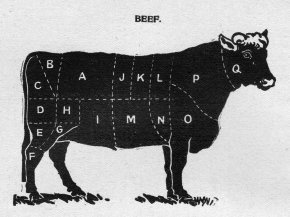Marbled veal
 The concept of marbled veal dates at least from 1817, when Dr. William Kitchiner included a recipe in Apicius Redidivus; Or, The Cook’s Oracle. The dish takes its name from the swirly appearance of its slices, and in modern incarnations takes the texture of a terrine. It has a bright flavor for a terrine because it is bound with gelatin as well as fat and includes a dramatic dose of a favored English flavoring, lemon zest. Our version is relatively inauthentic in omitting the tongue that is common to the older recipes (see the Notes) but out of practicality rather than preference: Tongue has gotten hard to find. Not a difficult recipe.
The concept of marbled veal dates at least from 1817, when Dr. William Kitchiner included a recipe in Apicius Redidivus; Or, The Cook’s Oracle. The dish takes its name from the swirly appearance of its slices, and in modern incarnations takes the texture of a terrine. It has a bright flavor for a terrine because it is bound with gelatin as well as fat and includes a dramatic dose of a favored English flavoring, lemon zest. Our version is relatively inauthentic in omitting the tongue that is common to the older recipes (see the Notes) but out of practicality rather than preference: Tongue has gotten hard to find. Not a difficult recipe.
Preheat the oven to 350°.
- ¾ lb ground pork shoulder
- ¾ lb ground veal
- 4 Tablespoons minced chives
- grated zest of a lemon
- 2 beaten eggs
- about 1/3 lb pork shoulder cut into irregular shapes
- 1 teaspoon gelatin dissolved in 3 Tablespoons hot veal, pork or chicken stock (in descending order of preference)
- ¼ teaspoon cayenne
- scant ¼ teaspoon mace
- salt and pepper
- ½ lb chicken breast cut into batons of roughly ½ x ½ x 4 inch size
- 4 Tablespoons chopped parsley
- Mix together the ground meat, chives, zest and eggs: There is no substitute for using your hands.
- Fold the cut pork and the gelatin slurry into the mix along with the cayenne and mace, then add heavy doses of salt and pepper.
- Butter a suitable terrine mold or rectangular bread pan and fill it with the mixture in three undulating layers, each separated by a bed of half the parsley, while arranging the chicken batons lengthwise and unevenly within the mixture of other meats as you spoon it into the mold or pan.
- Cover the terrine, place it in a bain marie halfway up the side of the container and bake the marbled veal for 1 ½ hours.
- Let the terrine cool, then weight it and refrigerate overnight.
- Turn the marbled veal out of its container and wipe the scummy fat from it with a paper towel before cutting the terrine into robust slices for service with cornichons, Cumberland sauce and mustard.
Notes:
- When we can find cooked tongue we use it, cut in rough chunks like the pork, instead of the chicken. Canned, cured tongue from Marks & Spencer is a viable alternative to something fresh; you will need less salt.
- Other alternatives to tongue include pheasant breast or lightly blanched sweetbreads trimmed of all membrane.
 - For a richer variation, instead of greasing your baking pan, line it with enough slices of bacon to encase the terrine.
- For a richer variation, instead of greasing your baking pan, line it with enough slices of bacon to encase the terrine.
- Dr. Kitchiner’s marbled veal is a sort of ornate potted meat. He builds his version by grinding the tongue separately from the other meats, forming it into clumps and scattering them to create the marbling effect.
- Marbled veal is one of those rare recipes or other endeavors in which carelessness pays, as Dr. Kitchiner explains in his version:
“Boil a neat’s tongue till it is tender, trim off all the fat and bones, and cut the tongue into small pieces, and pound it in a mortar with a quarter of a pound of butter, till it is very fine; pound the like quantity of dressed veal in the same way with pepper and salt and a little grated nutmeg; when the veal is pounded very fine, lay part of it in the bottom of an earthen pan, tongue in lumps upon the veal, not in any shapes, but the more careless the better, as it will look better when it is cut out, then put another layer of the veal upon the tongue, and press it down close; cover it with clarified butter; send it to the table cut into slices, and garnished with sprigs of curled parsley.”
- This is good prose, humorous and informative, from a time when culinary giants strode the streets of England--not unlike the 1970s.
- You could substitute nutmeg for the mace in the britishfoodinamerica version too.
- A later version from Eliza Leslie’s Directions for Cookery, in its Various Branches (London 1840) is in fact another potted meat. She grinds (literally “pounds” like Kitchiner; we, however, have meat grinders and food processors) cooked veal and tongue separately and binds them with softened butter before putting distinct lumps of each mixture into a pot. It looks like she lifted the recipe from the Oracle.
- “You may,” as she advises, “use it for sandwiches.”

